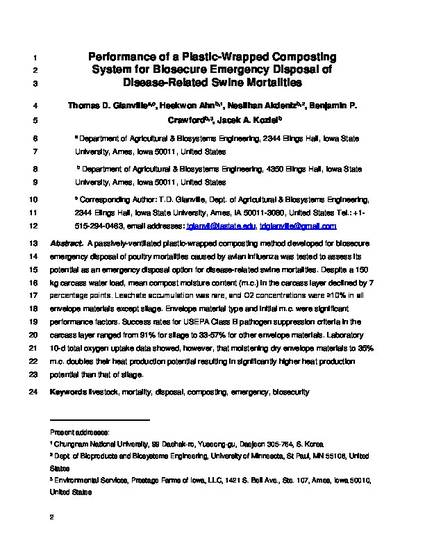
A passively-ventilated plastic-wrapped composting system initially developed for biosecure disposal of poultry mortalities caused by avian influenza was adapted and tested to assess its potential as an emergency disposal option for disease-related swine mortalities. Fresh air was supplied through perforated plastic tubing routed through the base of the compost pile. The combined air inlet and top vent area is ⩽∼1% of the gas exchange surface of a conventional uncovered windrow. Parameters evaluated included: (1) spatial and temporal variations in matrix moisture content (m.c.), leachate production, and matrix O2 concentrations; (2) extent of soft tissue decomposition; and (3) internal temperature and the success rate in achieving USEPA time/temperature (T) criteria for pathogen reduction. Six envelope materials (wood shavings, corn silage, ground cornstalks, ground oat straw, ground soybean straw, or ground alfalfa hay) and two initial m.c.’s (15–30% w.b. for materials stored indoors, and 45–65% w.b. to simulate materials exposed to precipitation) were tested to determine their effect on performance parameters (1–3). Results of triple-replicated field trials showed that the composting system did not accumulate moisture despite the 150 kg carcass water load (65% of 225 kg total carcass mass) released during decomposition. Mean compost m.c. in the carcass layer declined by ∼7 percentage points during 8-week trials, and a leachate accumulation was rare. Matrix O2 concentrations for all materials other than silage were ⩾10% using the equivalent of 2 m inlet/vent spacing. In silage O2 dropped below 5% in some cases even when 0.5 m inlet/vent spacing was used. Eight week soft tissue decomposition ranged from 87% in cornstalks to 72% in silage. Success rates for achievement of USEPA Class B time/temperature criteria ranged from 91% for silage to 33–57% for other materials. Companion laboratory biodegradation studies suggest that Class B success rates can be improved by slightly increasing envelope material m.c. Moistening initially dry (15% m.c.) envelope materials to 35% m.c. nearly doubled their heat production potential, boosting it to levels ⩾silage. The ‘contradictory’ silage test results showing high temperatures paired with slow soft tissue degradation are likely due to this material’s high density, low gas permeability and low water vapor loss. While slow decomposition typically suggests low microbial activity and heat production, it does not rule out high internal temperatures if the heat produced is conserved. Occasional short-term odor releases during the first 2 weeks of composting were associated with top-to-bottom gas flow which is contrary to the typical bottom-to-top flow typically observed in conventional compost piles. In cases where biosecurity concerns are paramount, results of this study show the plastic-wrapped passively-ventilated composting method to have good potential for above-ground swine mortality disposal.
Available at: http://works.bepress.com/jacek_koziel/167/

This article is published as Glanville, Thomas D., Heekwon Ahn, Neslihan Akdeniz, Benjamin P. Crawford, and Jacek A. Koziel. "Performance of a plastic-wrapped composting system for biosecure emergency disposal of disease-related swine mortalities." Waste Management 48 (2016): 483-491. DOI: 10.1016/j.wasman.2015.11.006. Posted with permission.